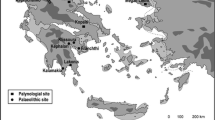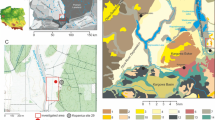Abstract
The ‘Altai Tavan Bogd’ conservation area, located between 2,000 and 4,000 m a.s.l. in the north-western part of the Mongolian Altai, is a montane forest-steppe-ecosystem which has developed under extreme continental and alpine climatic conditions and is very sensitive to natural variations. Nomadic peoples have influenced the area due to grazing, logging of trees and fire for a long time. To reconstruct the dynamics of this unique forest-steppe ecosystem for the last 4,000 years under the influence of climatic changes and/or nomads, palynological and macro-charcoal analyses of the radiocarbon dated core G2-A have been performed. Between 3,880 and 2,610 cal bp the vegetation was represented by a mixture of rather open forests and non-forested high mountain steppe areas suggesting a moist and warm climate similar to the present conditions. Macro-charcoal analysis reveals three main fire events, which are probably of anthropogenic origin. In the period from 2,610 to 550 cal bp a decrease in precipitation and temperature is suggested by a higher representation of herbaceous species, retreating open forests and an increase in macro-charcoal concentration. Since 550 cal bp the forest spread out again, whereas the composition of trees differs from the period between 3,880 and 2,610 cal bp. It is characterized by the shrubs Betula rotundifolia and Juniperus indicating a more open forest, which is probably related to human activities. The advancing upper forest line and a higher plant diversity reveals that the conditions changed to a more humid climate again, lasting until present.









Similar content being viewed by others
References
Andreev AA, Pierau R, Kalugin IA, Daryin AV, Smolyaninova LG, Diekmann B (2007) Environmental changes in the northern Altai during the last millennium documented in Lake Teletskoye pollen record. Quat Res 67:394–399
Beug HJ (2004) Leitfaden der Pollenbestimmung für Mitteleuropa und angrenzende Gebiete. Pfeil, München
Blaauw M, Christen JA (2011) Flexible paleoclimate age-depth models using an autoregressive gamma process. Bayesian Anal 6:457–474
Chenlemuge T, Hertel D, Dulamsuren C, Khishigjargal M, Leuschner C, Hauck M (2013) Extremely low fine root biomass in Larix sibirica forests at the southern drought limit of the boreal forest. Flora 208:488–496
D’Arrigo R, Jacoby G, Frank D et al (2001) 1738 years of mongolian temperature variability inferred from a tree-ring width chronology of siberian pine. Geophys Res Lett 28:543–546
Dulamsuren C, Khishigjargal M, Leuschner C, Hauck M (2014) Response of tree-ring width to climate warming and selective logging in larch forests of the Mongolian Altai. J Plant Ecol 7:24–38
Earle CJ (2015) The gymnosperm database. http://www.conifers.org. Accessed 22 February
Ekberg I, Eriksson G (1966) Development and fertility of pollen in three species of Larix. Hereditas 57:303–311
El-Moslimany AP (1990) Ecological significance of common nonarboreal pollen: Examples from drylands of the Middle East. Rev Palaeobot Palynol 64:343–350
Fægri K, Iversen J (1989) In: Fægri K, Kaland PE, Krzywinski K (eds) Textbook of pollen analysis. 4th edn. Wiley, Chichester
Fernandez-Gimenez ME (1999) Sustaining the steppes: a geographical history of pastoral land use in Mongolia. Geogr Rev 89:315–342
Grimm E (1987) CONISS: A FORTRAN 77 program for stratigraphically constrained cluster analysis by the methods of incremental sum of squares. Comput Geosci 13:13–15
Grimm E (1991) TILIA and TILIAGRAPH. Illinois State Museum, Springfield
Gunin PD, Vostokova EA, Dorofeyuk NI, Tarasov PE, Black CC (1999) Vegetation dynamics of Mongolia. Kluwer, Dordrecht
Havinga AJ (1967) Palynology and pollen preservation. Rev Palaeobot Palynol 2:81–98
Herzschuh U (2006) Palaeo-moisture evolution in monsoonal Central Asia during the last 50,000 years. Quat Sci Rev 25:163–178
Herzschuh U (2007) Reliability of pollen ratios for environmental reconstructions on the Tibetan Plateau. J Biogeogr 34:1,265–1,273
Higuera PE, Brubaker LB, Anderson PM, Hu FS, Brown TA (2009) Vegetation mediated the impacts of postglacial climatic change on fire regimes in the south-central Brooks Range, Alaska. Ecol Monogr 79:201–219
Higuera PE, Peters ME, Brubaker LB, Gavin DG (2007) Understanding the origin and analysis of sediment-charcoal records with a simulation model. Quat Sci Rev 26:1,790–1,809
Hilbig W (1995) The vegetation of Mongolia. SPB Academic Publishing, Amsterdam
Ilyashuk BP, Ilyashuk EA (2007) Chironomid record of Late Quaternary climatic and environmental changes from two sites in Central Asia (Tuva Republic, Russia)—local, regional or global causes? Quat Sci Rev 26:705–731
Jäger EJ (2011) Rothmaler—Exkursionsflora von Deutschland. Gefäßpflanzen: Grundband. 20. Auflage. Spektrum Akademischer Verlag, Heidelberg
Kalugin I, Selegei V, Goldberg E, Seret G (2005) Rhythmic fine-grained sediment deposition in Lake Teletskoye, Altai, Siberia, in relation to regional climate change. Quat Int 136:5–13
Kürschner H, Herzschuh U, Wagner D (2005) Phytosociological studies in the north-eastern Tibetian Plateau (NW China)—a first contribution to the scrub and alpine meadow vegetation. Bot Jahrb Syst Pflanzengesch Pflanzengeogr 126:273–315
Liu H, Cui H, Pott R, Speier M (1999) The surface pollen of the woodland-steppe ecotone in southeastern Inner Mongolia, China. Rev Palaeobot Palynol 105:237–250
Liu X, Herzschuh U, Shen J, Jiang Q, Xiao X (2008) Holocene environmental and climatic changes inferred from Wulungu Lake in northern Xinjiang, China. Quat Res 70:412–425
Lkhagvadorj D, Hauck M, Dulamsuren C, Tsogtbaatar J (2013) Pastoral nomadism in the forest-steppe of the Mongolian Altai under a changing economy and warming climate. J Arid Environ 88:82–89
Murad W (2011) Late Quaternary vegetation history and climate change in the Gobi Desert, South Mongolia. Dissertation, Georg-August-University Göttingen
Mustaphi CJ, Pisaric MFJ (2014) A classification for macroscopic charcoal morphologies found in Holocene lacustrine sediments. Prog Phys Geogr 38:734–754
Oksanen J (2013) Multivariate analysis of ecological communities in R: Vegan Tutorial. http://cc.oulu.fi/%7Ejarioksa/opetus/metodi/vegantutor.pdf
Reimer PJ, Bard E, Bayliss A et al (2013) IntCal13 and Marine13 radiocarbon age calibration curves 0–50,000 year cal bp. Radiocarbon 55:1,869–1,887
RStudio Team (2016) RStudio: integrated development for R. RStudio, Inc., Boston. http://www.rstudio.com/. Accessed 30 Nov 2016
Rudaya NA, Li HC (2013) A new approach for reconstruction of the Holocene climate in the Mongolian Altai: The high-resolution δ13C records of TOC and pollen complexes in Hoton-Nur Lake sediments. J Asian Earth Sci 69:185–195
Rudaya NA, Nazarova L, Novenk E et al (2016) Quantitative reconstructions of mid- to late Holocene climate and vegetation in the north-eastern Altai Mountains recorded in Lake Teletskoye. Glob Planet Chang 141:12–24
Rudaya NA, Tarasov PE, Dorofeyuk NI, Kalugin IA, Andreev AA, Diekmann B, Daryin AV (2008) Environmental changes in the Mongolian Altai during the Holocene. Arch Ethnol Anthropol Eurasia 36:2–14
Rudaya NA, Tarasov PE, Dorofeyuk NI et al (2009) Holocene environments and climate in the Mongolian Altai reconstructed from the Hoton-Nur pollen and diatom records: a step towards better understanding climate dynamics in Central Asia. Quat Sci Rev 28:540–554
Schlütz F, Dulamsuren C, Wieckowska M, Mühlenberg M, Hauck M (2008) Late Holocene vegetation history suggests natural origin of steppes in the northern Mongolian mountain taiga. Palaeogr Palaeoclimatol Palaeoecol 261:203–217
Schlütz F, Lehmkuhl F (2007) Climatic change in the Russian Altai, southern Siberia, based on palynological and geomorphological results with implications on climatic teleconnections and human history since the middle Holocene. Veget Hist Archaeobot 16:101–118
Schlütz F, Miehe G, Lehmkuhl F (2007) Zur Geschichte des größten alpinen Ökosystems der Erde: Palynologische Untersuchungen zu den Kobresia-Matten SE-Tibets. Ber Reinhold-Tüxen-Ges 19:23–36
Schwanghart W, Frechen M, Kuhn NJ, Schüttin B (2009) Holocene environmental changes in the Ugii Nuur basin, Mongolia. Palaeogeogr Palaeoclimatol Palaeoecol 279:160–171
Soma T (2014) Current situation and issues of transhumant animal herding in Sagsai County, Bayan-Ulgii Province, Western Mongolia. E-J GEO 9:102–119
Sommer M, Treter U (1999) Die Lärchenwälder der Gebirgswaldsteppe in den Randgebieten des Uvs Nuur-Beckens. Erde 2:173–188
Stevenson J, Haberle S (2005) Macro Charcoal Analysis: a modified technique used by the Department of Archaeology and Natural History. Palaeoworks Technical Papers 5. Australian National University, Canberra
Tao SC, An CB, Chen FH et al (2010) Pollen-inferred vegetation and environmental changes since 16,7 ka bp at Balikun Lake, Xinjiang. Chin Sci Bull 55:2,449–2,457
Tarasov P, Dorofeyuk N, Metel’tseva E (2000) Holocene vegetation and climate changes in Hoton-Nur basin, northwest Mongolia. Boreas 29:117–126
Tian F, Herzschuh U, Dallmeyer A, Xu Q, Mischke S, Biskaborn B (2013) Environmental variability in the monsoon-westerlies transition zone during the last 1200 years: lake sediment analyses from central Mongolia and supra-regional synthesis. Quat Sci Rev 73:31–47
Umbanhowar CE, McGrath MJ (1998) Experimental production and analysis of microscopic charcoal from wood, leaves and grasses. Holocene 8:341–346
Umbanhowar CE, Shinneman ALC, Tserenkhand G, Hammon ER, Lor P (2009) Regional fire history based on charcoal analysis of sediments from nine lakes in western Mongolia. Holocene 19:611–624
Van Geel B, Buurman J, Brinkkemper O, Schelvis J, Aptroot A, van Reenen G, Hakbijl T (2003) Environmental reconstruction of a Roman Period settlement site in Uitgeest (The Netherlands), with special reference to coprophilous fungi. J Archaeol Sci 30:873–883
Wang W, Ma YZ, Feng ZD, Meng H, Sang Y, Zhai XW (2009) Vegetation and climate changes during the last 8660 cal. y. bp in central Mongolia, based on a high-resolution pollen record from Lake Ugii Nuur. Chin Sci Bull 54:1,579–1,589
Wang W, Ma YZ, Feng ZD, Narantsetseg T, Liu KB, Zhai XW (2011) A prolonged dry mid-Holocene climate revealed by pollen and diatom records from Lake Ugii Nuur in central Mongolia. Quat Int 229:74–83
Wesche K, Miehe S, Miehe G (2005) Plant communities of the Gobi Gurvan Sayhan National Park (South Gobi Aymag, Mongolia). Candollea 60:149–205
Zhang Q, Cheng G, Yao T, Kang X, Huang J (2003) A 2326-year tree-ring record of climate variability on the northeastern Qinghai-Tibetan Plateau. Geophys Res Lett 30:1,739–1,742
Zhao Y, Liu H, Li F et al (2012) Application and limitations of the Artemisia/Chenopodiaceae pollen ratio in arid and semi-arid China. Holocene 22:1,385–1,392
Acknowledgements
This research project (AZ: BE 2116/28-1) was funded by the German Science Foundation (DFG) and carried out at Georg-August-Universität Göttingen, Germany. We are grateful to the team of G. Punsalpaamuu from the Mongolian State University of Education, Ulaanbaatar, and U. Beket from Bayan-Ulgii for their kind help in the field work. U. Nüsse-Hahne is thanked for her help in the laboratory work. Lyudmila Shumilovskikh is thanked for reading the manuscript. Additionally, we want to thank two anonymous reviewers for their helpful comments and kind advice.
Author information
Authors and Affiliations
Corresponding author
Additional information
Communicated by Y. Zhao.
Rights and permissions
About this article
Cite this article
Unkelbach, J., Dulamsuren, C., Punsalpaamuu, G. et al. Late Holocene vegetation, climate, human and fire history of the forest-steppe-ecosystem inferred from core G2-A in the ‘Altai Tavan Bogd’ conservation area in Mongolia. Veget Hist Archaeobot 27, 665–677 (2018). https://doi.org/10.1007/s00334-017-0664-5
Received:
Accepted:
Published:
Issue Date:
DOI: https://doi.org/10.1007/s00334-017-0664-5




